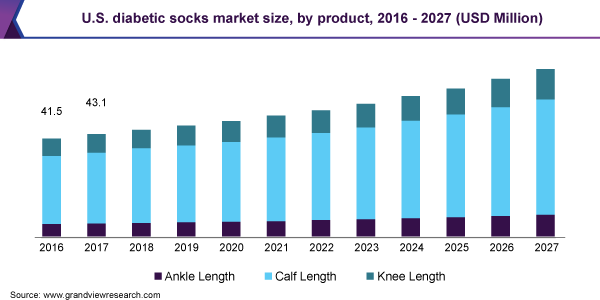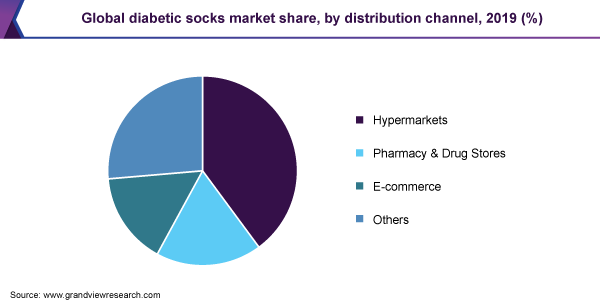- Home
- »
- Clothing, Footwear & Accessories
- »
-
Global Diabetic Socks Market Size Report, 2020-2027GVR Report cover
![Diabetic Socks Market Size, Share & Trends Report]()
Diabetic Socks Market Size, Share & Trends Analysis Report By Product (Ankle Length, Calf Length, Knee Length), By Distribution Channel (Hypermarkets, E-commerce), By Region, And Segment Forecasts, 2020 - 2027
- Report ID: GVR-4-68038-996-8
- Number of Report Pages: 80
- Format: PDF, Horizon Databook
- Historical Range: 2016 - 2018
- Forecast Period: 2020 - 2027
- Industry: Consumer Goods
Report Overview
The global diabetic socks market size was valued at USD 196.9 million in 2019 and is expected to grow at a compound annual growth rate (CAGR) of 5.5% from 2020 to 2027. The rising number of diabetic neuropathy cases across the globe is one of the prominent factors fueling the growth of the market. Diabetes is a condition when nerves get damaged as a result of high blood sugar and it starts with loss of sensation in the feet and legs, which can further develop into foot ulcers. According to the American Diabetes Association, close to 50% of people with type 2 diabetes and 20% of those with type 1 diabetes have been witnessing this kind of nerve damage cases. Wearing diabetic socks are considered a preventive measure as they provide required support and mild compression to the legs and feet. Increasing awareness regarding the benefits of these socks is expected to drive the demand during the forecast period.

An increasing number of diabetic patients worldwide is expected to drive the market. According to Diabetes UK, it is estimated that close to 415 million people are living with diabetes in the world as of 2019, which is estimated to be 1 in 11 of the world’s adult population. This figure is expected to rise to 642 million people living with diabetes worldwide by 2040. An enormous range of disease complications associated with diabetes is changing the way consumers adopt diabetic socks, not only as medicinal apparel but also as a new-age medical accessory.
Smart socks are the most current advancement in diabetic socks. Besides offering comfort to the wearer, these socks are equipped with fiber optic sensors, which can scan lower legs of the patient for weight, humidity, and foot joints to be aware of the possible development of ulcers in portions of nerve damage. This technological advancement will significantly reduce the number of removals and deaths due to foot ulcers and contamination, which have been witnessed by close to 10% of people suffering from diabetes.
Enthused by high demand for diabetic socks among consumers, many startups have been venturing into the market with an innovative product offering to attract a large number of customers. For instance, Siren, a U.S.-based startup formed in the year 2015, has developed diabetic socks with embedded microsensors. Each sock is fitted with six sensors, so 12 sensors for every pair of socks. These socks make use of neurofabric technology, which helps to monitor foot temperatures with the idea of prior detect potential foot injuries. Additionally, manufacturers have been focusing on the comfortableness of the socks by using neuro fabric material and gel padding material to reduce temperature, redness, irritation, nerve damage, blisters, or fungus. They are also machine-washable and do not need to be charged.
Another prominent feature added by many manufacturers includes moisture-wicking fabrics to keep the feet dry so that extra moisture is not a breeding ground for infections with fungi and antimicrobial features in the fabric prevent fungal and bacterial growth. Advances have been made in these textiles by incorporating extra padding for vulnerable areas, such as the sole of the feet, which helps to avoid foot injury.
High costs associated with diabetic socks and alternate treatment options, such as insulin, diet, and exercise, are among the major factors expected to restrain the growth of the market over the forecast timeframe.
Product Insights
The calf-length diabetic socks segment accounted for the largest revenue share of 68.3% in 2019. The segment is expected to maintain the lead over the forecast period. The majority of people with diabetes suffer from diabetic neuropathy and peripheral vascular disease, which leads to serious infections and complications. For this, many diabetic socks manufacturers are focusing on customized solutions to meet the specific medical requirements of diabetic patients, which, in turn, would reflect positively on the growth of the global market. For example, Verne Bintz Company manufactures Care sox plus, which is designed for people with large legs and feet, who have trouble finding socks large enough to fit them. These stretch to as much as 25 inches in circumference and feature light padding, making it customized.
The knee-length diabetic socks segment is the fastest-growing segment with a CAGR of 5.9% from 2020 to 2027. Knee-length socks are mostly preferred when there is low blood circulation and these socks are designed to control moisture in order to reduce the risk of fungal infection or with cushioning to prevent foot ulcers. For example, Skinnies Therapeutic Socks has specialist synthetic yarn used to remove some moisture while helping to preserve emollients and creams in order to hydrate the skin effectively.
Distribution Insights
Hypermarkets accounted for the largest revenue share of 39.9% in 2019. Trends in the distribution channels underscore an increased consumer inclination towards buying products from offline stores, such as pharmacy and drug stores hypermarkets. People prefer to buy these products through stores by physically verifying the durability and material used in the socks. People have become more conscious about the quality of medical-grade products, which is one of the main reasons fueling the segment growth.

The e-commerce channel is projected to register the fastest CAGR of 6.7% over the forecast period. The growth of the e-commerce industry globally is expected to change market dynamics in the coming years. Consumers are showing a shift in purchasing patterns, particularly in developed regions, such as North America and Europe, with increased shipments of diabetic socks purchased through online distribution channels. For instance, a fast search on eBay shows that diabetic socks sell well with a conversion rate of about 50%. Leading players in the market for diabetic socks have been continuously joining forces with online distribution networks, like Amazon, Walmart, and Sockswholesale.com, to meet the demand of a wider customer base and improve their competitive worldwide sales. For instance, SmartKnit, a diabetic socks manufacturer, provides information about foot care for diabetics and links to online retailers who carry products, including FootSmart and For Your Legs.
Regional Insights
North America accounted for the largest revenue share of 29.2% in 2019. In 2019, as per the American Diabetes Association, every year, there are around 1.5 million Americans diagnosed with diabetes, which bodes well for the market in this region. The presence of leading manufacturers of diabetic socks and strong export networks worldwide are among the major factors for market growth. For instance, in February 2018, Therafrim was awarded the distinction of being the top rural exporter in North Carolina. The company exports its products to over 50 countries and all the materials used for manufacturing come from the United States. In 2017, the company increased its production and revenue by 20% compared with 2016.
Europe is expected to expand at a CAGR of 5.6% from 2020 to 2027. A growing number of diabetes cases are expected to driving the market in the region. The region has one of the highest number of children and adolescents (0-19 years) with type-1 diabetes. In addition, rapid technological proliferation, joint ventures, and mergers and acquisitions are expected to significantly impact market growth. For instance, in April 2017, SCA (Svenska Cellulosa AB) acquired BSN Medical and the selling price for the stock was 1.70 Bn US dollars. This acquisition is expected to provide opportunities for the company's accelerated growth through cross-sales.
Key Companies & Market Share Insights
The market for diabetic socks is highly fragmented due to the presence of regional and domestic players. The market is expected to witness the whirlwind of action from local manufacturers. Companies with a strong brand image will build traction and new companies who leverage technology will continue to enjoy a greater portion of the marketplace. Some of the prominent players in the diabetic socks market include:
-
BSN Medical
-
SIGVARIS
-
SIMCAN
-
3M
-
Syounaa
-
HangZhou Aidu Trading Co., Ltd.
-
Soyad Brothers LLC.
-
DJO, LLC
-
PediFix Inc.
-
Cupron
-
Thorlo Inc.
-
Reflexa
Diabetic Socks Market Report Scope
Report Attribute
Details
Market size value in 2020
USD 205.0 million
Revenue forecast in 2027
USD 303.2 million
Growth Rate
CAGR of 5.5% from 2020 to 2027
Base year for estimation
2019
Historical data
2016 - 2018
Forecast period
2020 - 2027
Quantitative units
Revenue in USD million and CAGR from 2020 to 2027
Report coverage
Revenue forecast, company ranking, competitive landscape, growth factors, and trends
Segments covered
Product, distribution channel, region
Regional scope
North America; Europe; Asia Pacific; Central & South America; MEA
Country scope
U.S.; U.K.; Germany; France; China; India; Brazil
Key companies profiled
BSN Medical; SIGVARIS; SIMCAN; 3M; Syounaa; HangZhou Aidu Trading Co., Ltd.; Soyad Brothers LLC.; DJO, LLC; PediFix Inc.; Cupron; Thorlo Inc.; Reflexa
Customization scope
Free report customization (equivalent up to 8 analysts working days) with purchase. Addition or alteration to country, regional & segment scope.
Pricing and purchase options
Avail customized purchase options to meet your exact research needs. Explore purchase options
Segments Covered in the ReportThis report forecasts revenue growth at the global, regional, and country levels and provides an analysis of the latest industry trends and opportunities in each of the sub-segments from 2016 to 2027. For the purpose of this study, Grand View Research has segmented the global diabetic socks market report based on the product, distribution channel, and region:
-
Product Outlook (Revenue, USD Million, 2016 - 2027)
-
Ankle length
-
Calf length
-
Knee-length
-
-
Distribution Channel Outlook (Revenue, USD Million, 2016 - 2027)
-
Hypermarkets
-
Pharmacy & Drug stores
-
E-commerce
-
Others
-
-
Regional Outlook (Revenue, USD Million, 2016 - 2027)
-
North America
-
The U.S.
-
-
Europe
-
Germany
-
The U.K.
-
France
-
-
Asia Pacific
-
China
-
India
-
-
Central & South America
-
Brazil
-
-
Middle East & Africa (MEA)
-
Frequently Asked Questions About This Report
b. The global diabetic socks market size was estimated at USD 196.9 million in 2019 and is expected to reach USD 205.0 million in 2020.
b. The global diabetic socks market is expected to grow at a compound annual growth rate of 5.5% from 2020 to 2027 to reach USD 303.2 million by 2027.
b. North America dominated the diabetic socks market with a share of 29.2% in 2019. This is attributable to rising healthcare awareness coupled with an increasing number of diabetic patients in the region willing to opt for non-invasive measures to treat diabetes.
b. Some key players operating in the diabetic socks market include TBSN medical, SIGVARIS, SIMCAN, 3M, Syounaa, HangZhou Aidu Trading Co., Ltd, Soyad Brothers LLC., DJO, LLC; PediFix Inc, Cupron, Thorlo Inc., and Reflexa.
b. Key factors that are driving the market growth include an increasing number of diabetics cases across the globe, growing awareness among the people regarding the benefits of diabetic socks coupled with product innovation in socks manufacturing.
Share this report with your colleague or friend.
![gvr icn]()
NEED A CUSTOM REPORT?
We can customize every report - free of charge - including purchasing stand-alone sections or country-level reports, as well as offer affordable discounts for start-ups & universities. Contact us now
![Certified Icon]()
We are GDPR and CCPA compliant! Your transaction & personal information is safe and secure. For more details, please read our privacy policy.
We are committed towards customer satisfaction, and quality service.
"The quality of research they have done for us has been excellent."





